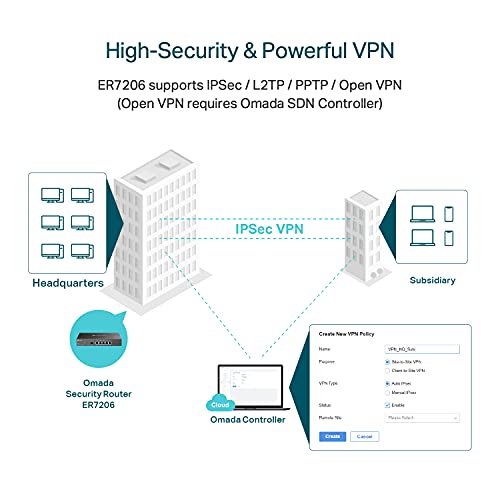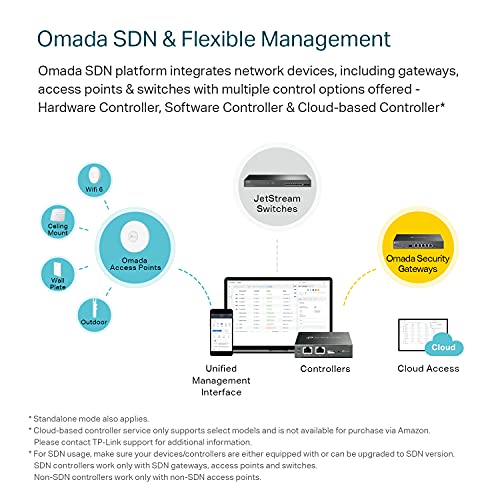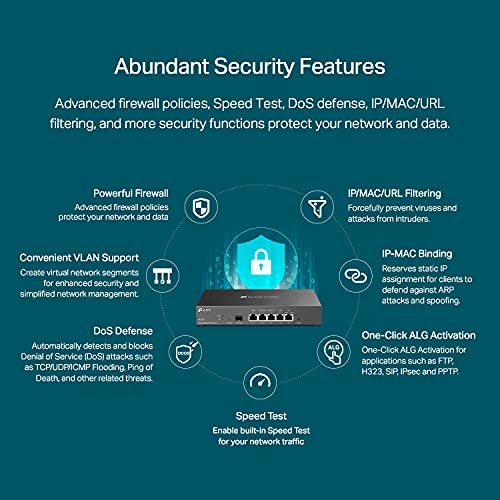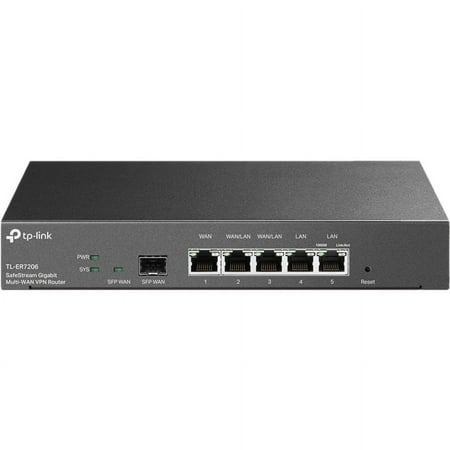TP-Link ER7206 Multi-WAN Gigabit VPN Router
Set Lowest Price Alert
×
Notify me, when price drops
Set Alert for Product: TP-Link ER7206 Multi-WAN Professional Wired Gigabit VPN Router Increased Network Capacity SPI Firewall Omada SDN Integrated Load Balance Lightning Protection - $139.99
Last Amazon price update was: January 25, 2025 23:08
×
Product prices and availability are accurate as of the date/time indicated and are subject to change. Any price and availability information displayed on Amazon.com (Amazon.in, Amazon.co.uk, Amazon.de, etc) at the time of purchase will apply to the purchase of this product.

TP-Link ER7206 Multi-WAN Gigabit VPN Router
$139.99
TP-Link ER7206 Multi-WAN Gigabit VPN Router Price comparison
TP-Link ER7206 Multi-WAN Gigabit VPN Router Price History
Price History for TP-Link ER7206 Multi-WAN Professional Wired Gigabit VPN Router Increased Network Capacity SPI...
Statistics
| Current Price | $139.99 | January 25, 2025 |
| Highest Price | $139.99 | August 10, 2024 |
| Lowest Price | $139.74 | August 26, 2024 |
Since August 10, 2024
Last price changes
| $139.99 | September 7, 2024 |
| $139.74 | August 30, 2024 |
| $139.99 | August 29, 2024 |
| $139.74 | August 26, 2024 |
| $139.99 | August 10, 2024 |
TP-Link ER7206 Multi-WAN Gigabit VPN Router Description
- 【Flexible Port Configuration】1 Gigabit SFP WAN Port + 1 Gigabit WAN Port + 2 Gigabit WAN/LAN Ports plus1 Gigabit LAN Port. Up to four WAN ports optimize bandwidth usage through one device.
- 【Increased Network Capacity】Maximum number of associated client devices – 150,000. Maximum number of clients – Up to 700.
- 【Integrated into Omada SDN】Omada’s Software Defined Networking (SDN) platform integrates network devices including gateways, access points & switches with multiple control options offered – Omada Hardware controller, Omada Software Controller or Omada cloud-based controller(Contact TP-Link for Cloud-Based Controller Plan Details). Standalone mode also applies.
- 【Cloud Access】Remote Cloud access and Omada app brings centralized cloud management of the whole network from different sites—all controlled from a single interface anywhere, anytime.
- 【SDN Compatibility】For SDN usage, make sure your devices/controllers are either equipped with or can be upgraded to SDN version. SDN controllers work only with SDN Gateways, Access Points & Switches. Non-SDN controllers work only with non-SDN APs. For devices that are compatible with SDN firmware, please visit TP-Link website.
- 【Abundant Security Features】Advanced firewall policies, DoS defense, IP/MAC/URL filtering, speed test and more security functions protect your network and data.
- 【Highly Secure VPN】Supports up to 100× LAN-to-LAN IPsec, 50× OpenVPN, 50× L2TP, and 50× PPTP VPN connections.
TP-Link ER7206 Multi-WAN Gigabit VPN Router Specification
Specification: TP-Link ER7206 Multi-WAN Gigabit VPN Router
|
TP-Link ER7206 Multi-WAN Gigabit VPN Router Reviews (9)
9 reviews for TP-Link ER7206 Multi-WAN Gigabit VPN Router
Show all
Most Helpful
Highest Rating
Lowest Rating
Only logged in customers who have purchased this product may leave a review.



























Jim –
I’ll start by saying that I’m a geek and my network needs aren’t that of a typical household. I segment my network with VLANs, I occasionally host services from infrastructure in my house, etc. I’ve used so many different routers, it’s hard to keep track… but I’ve been wanting to simplify and go back to more of an “appliance” than a computer running a firewall/router operating system like PFsense, OPNsense, or Untangle.
I originally tried the cheaper version of this the ER605 but it lacks the ability to apply ACLs that permit traffic from one VLAN to another, while restricting the inverse (very important for those wanting to isolate their IoT devices). The ER7206 just received this capability in a November firmware update, so I thought I should give it a try.
Of note, I also have two TP-Link Omada Wireless Access Points and liked the thought of consolidating the management interfaces for those with that of my router.
I’ve been up and running on the ER7206 now for a couple of weeks and it’s been rock solid. I have isolated my IoT network but still have access to it from the LAN. Very good. I have my guest network in place. I have my DMZ when I need it for hosting. Another benefit of this device as a Bell fiber subscriber is I am able to plug my fiber connection directly into this router thus eliminating the need for Bell’s Home Hub 3000 or some other fiber to ethernet converter box.
There is still a gap you should be aware of. There doesn’t seem to be a way (yet?) to permit traffic from one vlan to another, on a specific port or to specific hosts. A common use case for me would be to host an instance of Pihole (DNS) on my LAN and allow my IoT devices to access Pihole for name resolution. I currently can’t do this.
Another common IoT network requirement is to use mDNS so devices on your LAN can communicate across to the IoT network (say an iPhone using Airplay to cast a video onto a TV set top box). I can say this works very well on this device. It’s literally one toggle and a choice of the networks involved. Very easy.
All in all, this works well enough that I’m going to deal with the minor limitations and watch the product mature through firmware updates. Recommended if you have intermediate or better knowledge of networking.
T. Trefan –
This is definitely a business router. I bought this to use for my family. Unfortunately there’s no blocking mac addresses or scheduling on it. The firmware is very basic and unintuitive.
Amazon Customer –
The configuration interface is the same as basically every other TP-Link device. No surprises there, but that does mean the menus are basic and very simple. At the very least this doesn’t require a controller and can be configured in standalone mode, however this lacks a lot of configuration options you would expect to see in a more enterprise-class device. I’m pretty disappointed with the firewall and security options, there are basically none.
As for performance, with iPerf3 and a few processes I can get 9.46 Gb across the WAN link in both directions which is fantastic. I had trouble getting the full 10Gb with HTTPS transfers or Ookla speedtests but I think that could be due to my cheap desktop NIC. Not sure. I wish there were at least some better options for traffic shaping.
The most curious thing was my WiFi performance tanked. With my pfsense router, my EAP660HD has no problem getting 800 to 900 Mb/s downloads on my wireless devices. When I swapped in the ER8411, my download and upload speeds dropped to ~ 150Mb/s. I could still get full speed to local devices on my network, but anything over the WAN had very poor performance. I couldn’t figure this out, and the ER8411 doesn’t have much in the way of a UI to diagnose it. Maybe a firmware bug or config default that I couldn’t see, not sure.
Lisa G –
I used to be pretty tech savvy…back in the day I upgraded RAM, added a secondary hard drive, partitioned a hard drive to run two different operating systems, and set up a home network with router, hubs, and switches.
Notice I said used to be…over the last 10 years or so I haven’t had a need to do any of those things. I bought my computers configured how I wanted them. I used the router provided by my ISP.
Last year, we were running in to signal/coverage problems with our home Wi-Fi. I’d been reading about the mesh Wi-Fi systems, and when I found a killer deal on Woot, decided to give the Deco system from TP-link a try. The setup was easy, and it solved our coverage problems.
In the last 3 years our ISP has had two major outages due to lines being cut by construction crews. These were both multi-day outages. The first time was annoying. The second time was a problem because I was working remotely that day, and had to get ready and drive in to work in the middle of my shift.
After the second time I decided to sign up for a secondary ISP. Overkill? Probably…but I hated always worrying about whether the internet would go down again.
With two inputs, I wanted a way to be able to use both of them, without having to physically disconnect one and plug the other in. I’d read about load balancing routers. I did a lot of research, and finally decided on the TP-link ER7206. It looked like it would do everything I needed. Well…it kind of did…
Once it came and I started to install it, I discovered that you need a controller to utilize the load balancing and multiple input features. You can either use a physical controller, or the cloud-based software. I was going to opt for the software, but then discovered you had to run it on Windows or Linux…and I have a Mac 🤦🏼♀️
So…I got back on Amazon and purchased a hardware controller (TP-link OC200 in case you wanted to know). The main difference between the OC200 and OC300 is the 200 is POE (power over Ethernet…I.e. no power cord…it gets its power from the Ethernet cord).
Ok, sounds like I have everything I need…router, hardware controller, and mesh system. We finally got the second ISP installed today, and I decided (on 3 hours of sleep) to bite the bullet and set up the new router. I started plugging things in, and was confused when the hardware controller didn’t power on when I connected the Ethernet cable…. Yeah, about that…the hardware controller can be powered by POE, but the new router ports aren’t POE.
I thought I was going to have to buy yet another piece of equipment and was getting quite frustrated at this point. Then I noticed there was a micro USB port in the back of the hardware controller…hooray! I tracked down a cord, and realized I didn’t have any outlets left in the install area. That was an easy fix though, I grabbed a power cube and got everything plugged in! Whew! I called my first ISP to approve the new router, and had one input running through the setup.
Next came the truly mind numbing steps, because I was about to jump off into the unknown…setting up the router and hardware controller. I ended up in a 3 hour long chat with TP-link tech support. During that time I also had to call my second ISP to authorize the new router. And I had to change the configuration of the primary Deco from router mode to access point mode.
But, after more than 4 hours total, we now have TWO internet services, running in to one router, with load balancing controlled by the hardware controller, and a mesh system for coverage. If the first ISP goes down, within 30-60 seconds the load balancing will automatically switch the network to the second one.
I knew I’d be sailing into uncharted territory, and didn’t expect things to go smoothly, but I’d hoped that I’d watched enough YouTube videos that I’d be able to figure it out…notsomuch. Huge shout out to TP-link tech support for literally walking me through the set up and making sure everything was working as is should be!
J. B –
Amazing functionality in on little box.
Great for small business requirements.
Requires a bit of network knowledge to get it setup for its core functionality, but it is worth the effort to have so much capability available.
Support was amazing. I was surprised that someone picked up the call after a few wait sessions.
My call was picked up by Mira. She was clear, she was efficient, she was intuitive.
I was amazed at how she was able to visualize what my setup/scenario was based on my verbal description.
I was even more amazed at her understanding what I wanted to do.
She then proceeded to provide me a step-by-step guidance as if she was watching my screen !!!
She should be appreciated for her support skills and the system/people who trained her should be supported for knowing what a real good support experience should be.
Highly recommend the product for its function and support.
Canuck Customer –
I bought this TP Link, load balancing router to replace an older TP Link model I was using, but that could no longer handle the load our household put on it.
Setup was very similar to my previous router, which made for an easy install, despite the fact that my previously used unit, in very good condition, lacked instructions. No worries, I just downloaded them from TP-Link.
I like the gigabyte port, as my previous router was limited to 100MB ports. I also am looking forward to a few of the other features (ex. Cloud based access) when I figure out how to use them. I also have noticed the improved performance in the routing and load balancing.
Hunter09 –
Facile da installare e configurare
Kruse Ludington –
This offers much better VPN speeds (throughput) than the TP-LInk TL-ER605 so if someone is considering buying that model, they should consider this instead for a few dollars more it is much faster with more memory and processing power. Although considered a business product it is well suited for the home. I see many “VPN routers” advertised which actually only support VPN connectivity for connecting into the network where the router resides ONLY as a VPN SERVER – for people to connect to it from the outside through a VPN tunnel – NOT for their router to connect as CLIENT to a VPN tunnel where the other end is a VPN server (for example connecting to an office remotely FROM this router, or connecting directly to an external VPN server for internet access through a VPN service provider). This router does both. For people using a VPN provider for security this is a good option especially as it is smarter to split the WiFi and VPN processing work across two devices so as to minimize the processing load on any one piece of networking equipment. However, at this time, it does not yet support acting as VPN CLIENT to connect to a VPN provider or external VPN server using the OpenVPN standard (that is coming shortly through a firmware update as this is a new product). Note, although the support staff is very responsive in a timely manner, they sometimes do not correctly answer complicated technical questions – for example saying something cannot be done when I have found a way to make it work. Until a recent firmware update which was available a few days ago, this unit would run very hot although it does not anymore after the update. Also this router does not support WOL (Wake On Lan) but for what can be considered a business class Wired VPN Router, that is typically not a requirement. The interface takes a little getting used to, although it does work quite well. This is a quality product, they only reason why I did not give it 5 stars is because of the tech support item mentioned earlier. However, if you have this router you should strongly consider getting the TP-Link Controller (model OC200 (home) or the newer OC300 (business)) – please see my review for the OC300 which I also own.
Philip Buonadonna –
Networking professional here. I bought this router because I received 10Gb capable internet service recently and needed a router that could support this. For the price, I’m impressed with the breadth of features this unit has (IPv4, IPv6 including Prefix Delegation, traffic analytics, and a variety of traffic shaping and VPN solutions). It also includes dual power supply which is usually a premium feature on way more expensive boxes.
My only gripe is that there are some tools missing for IPv6 (e.g. ping and traceroute don’t function for IPv6)